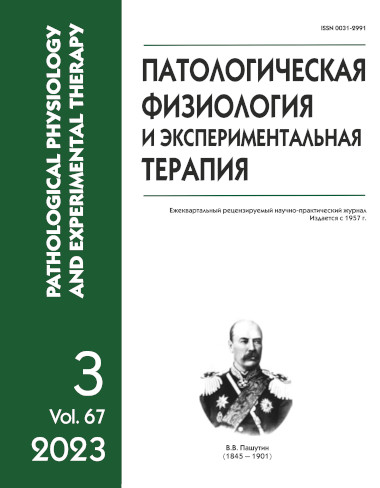Relationship of pro-oncogenic microRNAs (-21, -221, -222) and tumor-suppressive microRNA-429 lymph with the thymus structure during chemotherapy and surgical treatment of breast cancer
Abstract
Aim. To study the relationship between the thymus structure and concentrations of microRNAs (miRNAs-21, -221, -222, -429) in the lymph of female Wistar rats during surgical treatment of breast cancer and subsequent CMF (cyclophosphamide, methotrexate, and fluorouracil) chemotherapy for chemically induced breast cancer (intramammary administration of N-methyl-N-nitrosourea). Methods. BC was modeled by 5 subcutaneous injections of N-methyl-N-nitrosourea (Sigma) at 7-day intervals. Lymph samples were withdrawn from the cisterna chyli of the thoracic lymphatic duct of anesthetized animals. Total RNA was isolated from the lymph using a Vector-Best reagent kit according to the manufacturer’s instructions. cDNA was obtained by microRNA reverse transcription (RT). Levels of the pro-oncogenic microRNA-21, microRNA-221, microRNA-222, and the tumor-suppressing microRNA-429 were measured in biological samples by real-time RT-PCR on a CFX96 amplifier (Bio-Rad Lab) with U6 small RNA (Vector-Best) as a reference gene. The absolute number of cells was counted in structural zones of the thymus on a standard area of 2025 µm2. The relationship between the thymus structure and microRNA (-21, -221, -222, -429) levels was assessed using the Spearman rank correlation coefficient. Results. After the surgical treatment of breast cancer, concentrations of pro-oncogenic miRNAs (-21, -222) in the lymph were decreased and the concentration of tumor-suppressing miRNA-429 was increased compared to untreated breast cancer. A relationship of miRNA-221 with immunoblasts was observed in the thymic cortical substance, where the numbers of medium and small lymphocytes were increased compared to breast cancer without the treatment. A relationship was found between miRNA21 and medium lymphocytes in the corticomedullary zone. In all the studied areas, the number of cells with pycnotic nuclei was reduced whereas the numbers of macrophages and epithelioreticular cells were increased. After resection of breast cancer and chemotherapy, the concentrations of miRNA-221 and miRNA-429 were reduced compared to the surgical treatment alone. In the cortical subcapsular region of the thymus, the number of small lymphocytes correlated with miRNA-221 and -429 and the number of mitotically dividing cells correlated with miRNA-429; in the central part of cortical substance, the number of small lymphocytes correlated with miRNAs -221 and -429, the number of cells with pycnotic nuclei correlated with miRNA-222, and the number of medium lymphocytes correlated with miRNA-429; in the cortico-medullary region, the number of medium lymphocytes correlated with miRNAs-21 and -221; and in the central medulla, the number of small lymphocytes correlated with miRNAs-21 and -429. Conclusion. After the surgical treatment of breast cancer and chemotherapy vs. the tumor resection alone, along with the morphological differences, the relationships observed between cells of thymic structures and pro-oncogenic and tumor-suppressing miRNAs in the cortical substance and medullary substance of the thymus may be due to increased proliferative activity, migration of T-lymphocytes from the thymus, increased cytotoxic mechanisms of the immune response, and increased number of dying cells.






